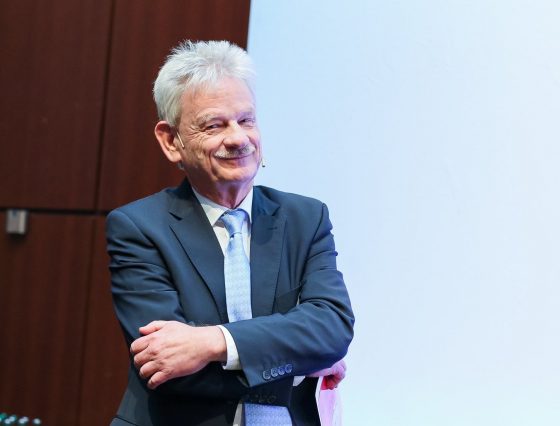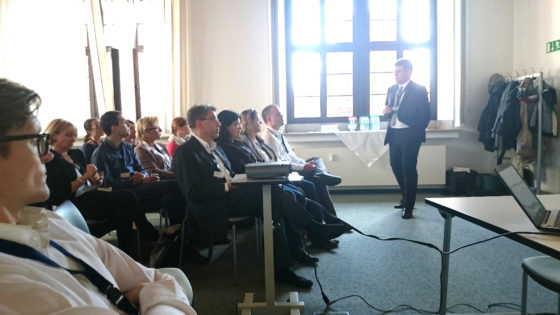
Innovation braucht Kreativität und Freiheiten – auch in Unternehmen. Oder braucht es dort mehr als das? Unbedingt, sagt Siegfried Gänßlen, bis 2018 Vorstandsvorsitzender und inzwischen Kuratoriumsmitglied im ICV. Im White Paper „Innovation: Sprung in die Zukunft – Schritte zum erfolgreichen Aufbau einer Innovationskultur“ betont er die Wichtigkeit von verlässlichen Rahmenbedingungen und internen Strukturen mit starker Führung und klaren Regeln, um der Innovationskraft den notwendigen Raum zu geben. Wir haben uns mit dem Executive Advisor, Schriftleiter ICV Fachkreis Innovationssteuerung und ehemaligen CEO der Hansgrohe SE über seine Empfehlungen unterhalten.
Wo endet im Unternehmen der Freiraum für kreative Ideen?
Gänßlen: Da, wo Inkompetenz beginnt. Innovative Kreativität hat nichts mit einer Wellness-Oase zu tun, sondern auch hier zählen – bei aller notwendigen Fehlertoleranz – Leistungen und Ergebnisse, Verantwortungsbewusstsein und Selbstständigkeit im Denken und Handeln.
Für erfolgreiche Unternehmen lauert eine Gefahr für ihre Innovationskraft: das sogenannte „innovators dilemma“. Was steckt dahinter?
Gänßlen: Wer erfolgreich ist, möchte am Status Quo festhalten und neigt zu übersteigertem Optimismus. Das kann dazu führen, dass Trends verschlafen werden. Deshalb braucht es ein gut verankertes „Ökosystem“ im Unternehmen, das nach ständiger Erneuerung und überproportionalem Wachstum mit Ertrag strebt.
Wo ist die Innovation im Unternehmen zu verankern?
Gänßlen: Sie muss fester Bestandteil der Unternehmensstrategie und Teil einer Unternehmenskultur sein, in der Aufgeschlossenheit, Neugier, Engagement und Motivation die Basis bilden. Wichtig ist, dass Teams funktionsübergreifend arbeiten und ihre Ergebnisse teilen. Und: Alle Unternehmensbereiche, das Management und die Stakeholder müssen sich zur Innovationsfreude bekennen und diese fördern. Das ist manchmal auch ein längerer Prozess.
Sie benennen in Ihrem White Paper auch „Innovationskiller“
Gänßlen: Innovation wird von Menschen, von Mitarbeitern gemacht. Diese müssen sich darauf verlassen können, dass ihr Engagement im Bereich Innovation anerkannt wird und Fehler oder gar Scheitern innerhalb klarer Rahmenbedingungen erlaubt sind. Ist das nicht der Fall, wird Innovation vermieden – aus Angst, Stress oder Bequemlichkeit. Auch starre Strukturen und Abläufe behindern Innovation, beispielsweise, wenn Neues mit alten KPIs gemessen wird.
Welche Strukturen muss ein Unternehmen beseitigen, möchte es die Innovationskraft in den eigenen Reihen sichern oder erhöhen?
Gänßlen: Zu vermeiden sind Micromanagement mit engmaschigen Kontrollen und Regeln sowie Silo-Denken (Abteilungsegoismus) mit mangelnder Risikobereitschaft. Stattdessen müssen Unternehmenswerte und Visionen zur Innovation motivieren sowie eine Feedback- und Mitmachkultur etabliert werden. Selbstverständlich braucht es auch ganz konkrete Mindestanforderungen wie eine ausreichende Anzahl an Ressourcen, transparente Strukturen und zur Verfügung stehende Räume. Dann aber heißt es: Experimentieren und testen, testen, testen – und nicht vergessen: Im Erfolgsfall müssen die Leistungen der Mitarbeiter durch Wertschätzung und Prämien anerkannt werden. So gelingt die Motivation, sich nicht auf dem Erreichten auszuruhen und in die Falle des „innovators dilemma“ zu geraten.
Das White Paper ist ein Ergebnis der Arbeit des ICV Fachkreises Innovationssteuerung, dem auch Siegfried Gänßlen angehört. Der Fachkreis erarbeitet und formuliert, welche Kultur, organisatorischen Voraussetzungen und Spielregeln in Unternehmen gegeben sein müssen, damit Innovation gelingen kann.
Das komplette White Paper mit detaillierten Erläuterungen und Fallbeispielen finden Sie im aktuellen Controller Magazin (das Abonnement ist in der ICV Mitgliedschaft enthalten), Ausgabe Juli/August 2021 sowie ab August 2021 auch im Bereich Controlling-Wissen auf der Website des ICV.
 Innovation needs creativity and freedom – also in companies. Or does it take more than that? Absolutely, says Siegfried Gänßlen, Chairman of the Board until 2018 and now a Member of the ICV Board of Trustees. In the white paper “Innovation: Leap into the Future – Steps to Build an Innovation Culture Successfully” he emphasizes the importance of reliable framework conditions and internal structures with strong leadership and clear rules to give innovative strength the necessary space. We talked to the Executive Advisor, Editor-In-Chief of the ICV expert work group Innovation Management and the former CEO of Hansgrohe SE about his recommendations.
Innovation needs creativity and freedom – also in companies. Or does it take more than that? Absolutely, says Siegfried Gänßlen, Chairman of the Board until 2018 and now a Member of the ICV Board of Trustees. In the white paper “Innovation: Leap into the Future – Steps to Build an Innovation Culture Successfully” he emphasizes the importance of reliable framework conditions and internal structures with strong leadership and clear rules to give innovative strength the necessary space. We talked to the Executive Advisor, Editor-In-Chief of the ICV expert work group Innovation Management and the former CEO of Hansgrohe SE about his recommendations.
Where does the freedom for creative ideas end in the company?
Gänßlen: Where incompetence begins. Innovative creativity has nothing to do with a wellness oasis, here also – with all the necessary tolerance for errors – performance and results, a sense of responsibility and independence in thinking and acting count.
For successful companies, there is a threat to their innovative strength: the so-called “innovators dilemma”. What’s behind it?
Gänßlen: Those who are successful want to hold onto the status quo and tend to be overly optimistic. This can lead to trends being overslept. That is why a well-anchored “ecosystem” is required in the company that strives for constant renewal and disproportionate growth with profit.
Where should you anchor the innovation in the company?
Gänßlen: It must be an integral part of the corporate strategy and part of a corporate culture in which open-mindedness, curiosity, commitment and motivation form the basis. It is important that teams work across functions and share their results. And: All areas of the company, management and stakeholders must acknowledge and encourage innovation. Sometimes this is a longer process.
You also name “innovation killers” in your white paper
Gänßlen: Innovation is made by people, by employees. They must be able to rely on their commitment to innovation being recognized and that mistakes or even failure are permitted within clear framework conditions. If this is not the case, innovation is avoided – out of fear, stress or comfort. Rigid structures and processes also hinder innovation, for example when new things are measured with old KPIs.
Which structures does the company have to eliminate if it wants to secure or increase the innovative strength in its own ranks?
Gänßlen: You have to avoid micromanagement with close-knit controls and rules as well as silo thinking (departmental selfishness) with a lack of willingness to take risks. Instead, corporate values and visions must motivate innovation and a culture of feedback and participation must be established. Of course, very specific minimum requirements are also needed, such as a sufficient number of resources, transparent structures and available spaces. But then it’s time to experiment and test, test, test – and don’t forget: In the event of success, you should recognize the performance of the employees through appreciation and rewards. This is how the motivation succeeds not to rest on what has been achieved and to fall into the trap of the “innovator’s dilemma”.
The white paper is a result of the work of the ICV expert work group Innovation Management, where Siegfried Gänßlen is a member. The expert work group works out and formulates which culture, organizational requirements and rules of the game must exist in companies so that innovation can succeed.
The complete white paper with detailed explanations and case studies can be found (IN GERMAN) in the current Controller Magazin (subscription is included in ICV membership in German-speaking countries), issue July / August 2021 and since August 2021 also in the Controlling Know-How section on the ICV website (so far also only IN GERMAN).



